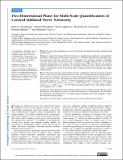| dc.contributor.author | Annunziata, Roberto | en_US |
| dc.contributor.author | Kheirkhah, Ahmad | en_US |
| dc.contributor.author | Aggarwal, Shruti | en_US |
| dc.contributor.author | Cavalcanti, Bernardo M. | en_US |
| dc.contributor.author | Hamrah, Pedram | en_US |
| dc.contributor.author | Trucco, Emanuele | en_US |
| dc.date.accessioned | 2016-11-18T20:05:34Z | |
| dc.date.issued | 2016 | en_US |
| dc.identifier.citation | Annunziata, Roberto, Ahmad Kheirkhah, Shruti Aggarwal, Bernardo M. Cavalcanti, Pedram Hamrah, and Emanuele Trucco. 2016. “Two-Dimensional Plane for Multi-Scale Quantification of Corneal Subbasal Nerve Tortuosity.” Investigative Ophthalmology & Visual Science 57 (3): 1132-1139. doi:10.1167/iovs.15-18513. http://dx.doi.org/10.1167/iovs.15-18513. | en |
| dc.identifier.issn | 0146-0404 | en |
| dc.identifier.uri | http://nrs.harvard.edu/urn-3:HUL.InstRepos:29407663 | |
| dc.description.abstract | Purpose To assess the performance of a novel system for automated tortuosity estimation and interpretation. Methods: A supervised strategy (driven by observers' grading) was employed to automatically identify the combination of tortuosity measures (i.e., tortuosity representation) leading to the best agreement with the observers. We investigated 18 tortuosity measures including curvature and density of inflection points, computed at multiple spatial scales. To leverage tortuosity interpretation, we propose the tortuosity plane (TP) onto which each image is mapped. Experiments were carried out on 140 images of subbasal nerve plexus of the central cornea, covering four levels of tortuosity. Three experienced observers graded each image independently. Results: The best tortuosity representation was the combination of mean curvature at spatial scales 2 and 5. These tortuosity measures were the axes of the proposed TP (interpretation). The system for tortuosity estimation revealed strong agreement with the observers on a global and per-level basis. The agreement with each observer (Spearman's correlation) was statistically significant (αs = 0.05, P < 0.0001) and higher than that of at least one of the other observers in two out of three cases (ρOUR = 0.7594 versus ρObs3 = 0.7225; ρOUR = 0.8880 versus ρObs1 = 0.8017, ρObs3 = 0.7315). Based on paired-sample t-tests, these improvements were significant (P < 0.001). Conclusions: Our automated system stratifies images by four tortuosity levels (discrete scale) matching or exceeding the accuracy of experienced observers. Of importance, the TP allows the assessment of tortuosity on a two-dimensional continuous scale, thus leading to a finer discrimination among images. | en |
| dc.language.iso | en_US | en |
| dc.publisher | The Association for Research in Vision and Ophthalmology | en |
| dc.relation.isversionof | doi:10.1167/iovs.15-18513 | en |
| dc.relation.hasversion | http://www.ncbi.nlm.nih.gov/pmc/articles/PMC4794090/pdf/ | en |
| dash.license | LAA | en_US |
| dc.subject | tortuosity plane | en |
| dc.subject | confocal microscopy | en |
| dc.subject | corneal subbasal nerve plexus | en |
| dc.title | Two-Dimensional Plane for Multi-Scale Quantification of Corneal Subbasal Nerve Tortuosity | en |
| dc.type | Journal Article | en_US |
| dc.description.version | Version of Record | en |
| dc.relation.journal | Investigative Ophthalmology & Visual Science | en |
| dash.depositing.author | Kheirkhah, Ahmad | en_US |
| dc.date.available | 2016-11-18T20:05:34Z | |
| dc.identifier.doi | 10.1167/iovs.15-18513 | * |
| dash.contributor.affiliated | Kheirkhah, Ahmad | |


